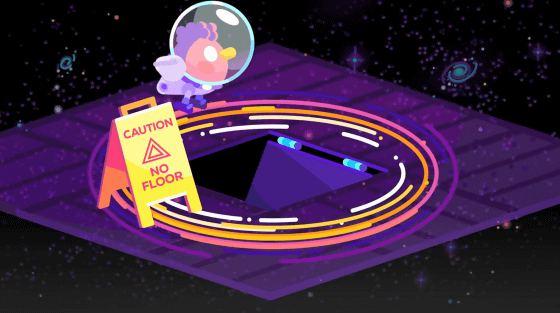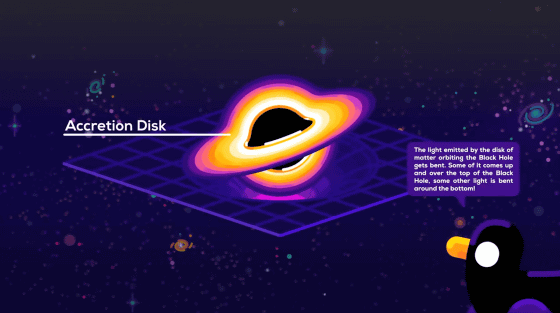What is a black hole, the 'most extreme entity in the universe'?

by
Black holes are super-high density celestial objects, but because of their extremely strong gravity, even light cannot escape from them, making it difficult to even observe them directly. Kurzgesagt , a science-based YouTube channel, explains black holes, the 'most extreme existence in the universe,' in a distinctive animated movie.
The Most Extreme Things in the Universe - Ultimate Guide to Black Holes - YouTube
Black holes are the most powerful and extreme things in the universe, yet they are also strange and complex.

Before we can think about black holes, Kurzgesagt says we need to get a handle on space and time: the universe exists in space and time, but space and time are not like a fixed stage.

Space and time are relative things...

The mass of an object can distort space, and the distortion of space can affect the movement of an object.

If a celestial body is in space, the space will be distorted and gravity will occur ...

A black hole is more like a trap than a distortion.

Black holes are the remains of massive stars that

Black holes, which are extremely dense and packed with massive mass, significantly distort space-time.

Even a black hole with a mass 10 times that of the sun would only have a diameter of about 60 km.

Within a certain radius of a black hole, an extremely strong gravitational field is formed, from which even light cannot escape. This radius is called

Not even light can escape from the event horizon, so it is completely black and nothing can be seen from the outside.

However, even if we cannot observe the black hole itself, it is possible to indirectly observe the black hole by observing the celestial body that is influenced by the black hole.

Many black holes also have a disk of material called

Matter in a black hole's accretion disk can accelerate to nearly half the speed of light, and due to minute friction and collisions between particles, it can reach temperatures as high as one billion degrees.

Therefore, while the event horizon is pitch black, the black hole's accretion disk is incredibly bright.

If you approach just outside the event horizon, you'll see your own image as light travels around the black hole and back again, because gravity makes the light travel around the black hole.

Gravity distorts not only light but also time. Time flows more slowly under strong gravity.

As you approach the event horizon, the world around you appears to speed up.

On the other hand, if you look at an object approaching the event horizon from a distance, it will appear as if it is moving in slow motion.

It is said that it is possible to travel to the future by taking advantage of the difference in time between near and outside a black hole, but approaching a black hole is extremely dangerous.

If the black hole were small, the gravitational forces acting on the head and feet of a person standing on the event horizon would be unequal, causing them to be stretched vertically like noodles, resulting in

When hit by the spaghetti phenomenon, it eventually turns into a stream of hot plasma.

It should be noted that the spaghettification phenomenon only occurs when the black hole is small; it is believed that a large black hole can pass through the event horizon without being stretched.

If you observe a person entering the event horizon from the outside, it will appear as if they have stopped moving, because time slows down due to the strong gravity.

On the other hand, from the perspective of a person entering the event horizon, the surroundings will be shrouded in darkness, with only a small spot from which the outside can be seen.

Inside the event horizon, space-time is distorted, so no matter how far you try to move forward, you'll be pulled towards the center of the black hole.


Matter compressed into a singularity loses all of its properties, so the only properties that can exist in a black hole are mass, angular momentum, and charge.

The differences between individual black holes are like the differences between

Because the singularity where the curvature and density of space-time become infinite cannot be calculated ...

Existing physical laws, including

Figuring out what a singularity is is a very difficult problem.

In addition, black holes are often rotating because they were born from dead stars, and some black holes rotate at 90% of the speed of light.

If the black hole is rotating very quickly, it will form

Outside the rotating black hole, there is a region called

There is a theory about what ultimately happens to a black hole based on

From a quantum mechanical perspective,

Normally, the particles and antiparticles produced by pair production collide and

Hawking thought that when pair production occurs near the event horizon, one of the particles falls into the singularity and the other escapes. This particle that escapes to the outside is called Hawking radiation.

Since the mass of the particles emitted by Hawking radiation comes from the black hole, it is believed that the black hole will eventually lose all its mass and disappear.

However, because black holes have such a large mass, it is believed that it would take a huge amount of time for them to lose all of their mass and disappear.

Understanding black holes is extremely difficult even with modern science...

That's why there are so many mysteries yet to be solved, and it's fun to explore them, Kurzgesagt concludes.

Related Posts:







